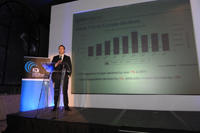London has maintained its title as fDi Magazine’s European City of the Future 2012/13, having claimed the top spot in the previous two rankings. The UK capital is followed by Paris in second place and Vienna in third. Other UK cities that have made it into the top 10 are Reading and Cambridge, in fifth and seventh places, respectively. Germany is represented by Munich (sixth) and Berlin (ninth), and Moscow, Dublin and Stockholm also feature in the top 10.
Editor's choice
London continues to be the largest recipient of FDI in Europe; the city received 376 greenfield FDI projects in 2011, according to data from fDi Markets – an increase of 16% on the number of projects recorded in 2010 and its highest annual figure since the company started data collection in 2003. London also topped the human resources, business friendliness and infrastructure categories. Even though it is not part of mainland Europe, London remains the most accessible city thanks to direct flights to more than 300 destinations and its proximity to large ports.
Vienna was the highest ranking European city of the future for economic potential and scored strongly because of its relative stability and innovative environment, with one of the largest number of patents granted of the cities in the competition. Oslo was the best European city of the future for quality of life. Berlin has been ranked by the independent judging panel as the best European city of the future for FDI promotion strategy and Antwerp in Belgium followed closely in second place.
Edinburgh in Scotland has been ranked as the best large city of the future, followed by Glasgow and Amsterdam in second and third positions, respectively. Edinburgh has been ranked by the judging panel as the best large city for FDI promotion strategy, and scores well in the human resources and quality of life categories, due to its high student population and well-educated workforce.
Advertisement
Bristol leads small cities
The best small city of the future is Bristol in the UK, scoring particularly well in the business friendliness category, due in part to its concentrated high-tech and knowledge-based sectors (high-tech manufacturing and information and communications technology). Antwerp and Zurich follow in second and third places, respectively. Zurich is the best small city for economic potential, followed by Antwerp and Belfast, while Duisburg in Germany is the highest scoring small city for infrastructure.
Reading and Cambridge in the UK are the only cities in the overall top 10 that are micro cities; Reading is ranked as the top micro city of the future. Luxembourg has been ranked as the micro city with the highest economic potential. It has the fourth highest income per capita of the cities in the competition (behind London, Paris and Oslo) and also scored highly for its quality of life and business friendliness. Bordeaux in France ranks highest for FDI strategy and places sixth in the micro cities ranking overall.
Cities in eastern Europe lead the way in the cost-effectiveness category, with Ternopil in the Ukraine ranked as the best European city of the future for cost effectiveness. Six of the top 10 cities in the category are in Ukraine, where foreign investors can avail of inexpensive labour costs, cheap utilities and affordable property. Yaroslavl in Russia is the best large city of the future for cost effectiveness.
Stockholm tops region list
The Greater Stockholm region of Sweden is the best small region of the future, and has overtaken the UK’s South-east to become fDi Magazine’s European Region of the Future 2012/13. The UK’s South-east region is ranked second overall and is the best large region of the future. Scotland and the Thames Valley also feature in the top ranked regions from the UK, while Ile-de-France and Nordrhein-Westfalen (Germany) remain in the top 10. At sixth, Prague region (Czech Republic) is the only eastern European region in the top 10 ranking.
Nordrhein-Westfalen was considered the best European region for FDI strategy by the judging panel, followed closely by Catalonia in Spain. The Bucharest-Ilfov development region (Romania) was the best European region of the future for cost effectiveness, followed by Indjija in Serbia. The Greater Dublin Region in Ireland is the best European region of the future for economic potential, on account of the large amount of FDI per capita it has attracted, especially greenfield FDI projects in R&D. The banking crisis in Ireland does not seem to have affected FDI into the Dublin region; project numbers were up 15% year on year in 2011, following the banking bailout at the end of 2010. Investors in Ireland benefit from a favourable corporation tax regime; 20% of FDI projects in the Greater Dublin Region in 2011 were classified as headquarters.
Cities and regions in northern and western Europe dominated the rankings; Moscow is the only city outside these regions to feature in the top 10 overall. There are exceptions, with Moscow and St Petersburg scoring well for human resources, and Warsaw and Prague among the top ranked cities for business friendliness. Southern Europe is the least represented region in the overall rankings; the past year has seen increased uncertainty in the eurozone and downgraded debt ratings for Greece, Italy and Portugal.
Methodology
fDi Cities and Regions of the Future shortlists were created from an independent collection of data by fDi Benchmark across 253 European cities and 110 European regions. This information was set under six categories: economic potential, human resources, cost effectiveness, quality of life, infrastructure and business friendliness. A seventh category was added to the scoring – FDI promotion strategy. In this category, 73 European cities and 60 regions submitted details about their promotion strategy and this was judged and scored by the independent judging panel.
Cities and regions scored up to a maximum of 10 points under each individual criterion, which were weighted by importance to give the overall scores. Where data was available at a national rather than city or regional level, a lower weighting was generally applied.
Categories
Major cities (population of more than 1 million)
Large cities (population of between 500,000 and 1 million)
Small cities (population of between 250,000 and 500,000)
Micro cities (population of less than 250,000)
Large regions (population of more than 250,000)
Small regions (population of up to 250,000)
Click on the link below for a PDF version of the complete results:
Download the European Cities of the Future 2011/12 Press Release here:
Download previous European Cities of the Future results here:
European Cities & Regions of the Future 2010/11
European Cities & Regions of the Future 2008/09
European Cities of the Future 2014/15:
To register your interest in the next ranking, fDi European Cities of the Future 2014/15 please contact jacqueline.walls@ft.com.
Photo Gallery
|
|
|
|
|
|
|
|
Click here for the full photo gallery.





